Martienssen W., Warlimont H. (Eds.). Handbook of Condensed Matter and Materials Data
Подождите немного. Документ загружается.


822 Part 4 Functional Materials
The physical quantities used to describe the properties of the dielectric substances are drawn up as follows.
Used Physical Qunatities, their Symbols and their Units
B
ij
(B
m
) relative dielectric impermeability dimensionless
C capacitance C/V
c
ijkl
(c
mn
) elastic stiffness tensor 10
9
Pa =GPa
D electric displacement field (or electric flux density) C/m
2
d
ijk
(d
in
) piezoelectric strain tensor 10
−12
C/N
E electric field V/m
n refractive index dimensionless
P polarization (dipole moment per unit volume of matter) C/m
2
p
ijkl
(p
mn
) elastooptic tensor dimensionless
q
ijkl
(q
mn
) piezooptic tensor 10
−9
Pa
−1
= (GPa)
−1
r
ijk
(r
mk
) electrooptic coefficient 10
−12
m/V = pm/V
r
S
mk
, r
T
mk
electrooptic coefficient at constant strain or stress, respectively 10
−12
m/V = pm/V
S
ij
(S
m
) strain tensor dimensionless
s
ijkl
(s
mn
) elastic compliance tensor 10
−12
Pa
−1
= (TPa)
−1
T
ij
(T
m
) stress tensor 10
9
Pa =GPa
tan δ dissipation factor (loss tangent) dimensionless
density g/cm
3
ε
0
dielectric constant (or permittivity) of free space (vacuum), 8.854 ×10
−12
C/Vm
ε relative dielectric constant (permittivity) dimensionless
κ
ij
thermal conductivity W/mK
v
s
mn
sound velocity in the direction mn m/s
χ
ij
χ
(1)
ij
linear dielectric susceptibility dimensionless
χ
(2)
ijk
, d
ijk
(d
im
) second-order nonlinear dielectric susceptibility 10
−12
m/V = pm/V
χ
(3)
ijkl
third-order nonlinear dielectric susceptibility 10
−22
m
2
/V
2
4.4.1 Dielectric Materials: Low-Frequency Properties
4.4.1.1 General Dielectric Properties
Density
The density of a substance is defined as the mass per
unit volume of the substance:
=
m
V
,
(4.1)
where V is the volume occupied by a mass m. The den-
sity is thus a measure of the volume concentration of
mass.
Mohs Hardness Scale
In 1832, Mohs introduced a hardness scale ranging from
1 to 10, based on ten minerals:
1. talc, Mg
3
H
2
SiO
12
;
2. gypsum, CaSO
4
·2H
2
O;
3. iceland spar, CaCO
3
;
4. fluorite, CaF
2
;
5. apatite, Ca
5
F(PO
4
)
3
;
6. orthoclase, KAlSi
3
O
8
;
Part 4 4.1

Dielectrics and Electrooptics 4.1 Dielectric Materials: Low-Frequency Properties 823
7. quartz, SiO
2
;
8. topaz, Al
2
F
2
SiO
4
;
9. corundum, Al
2
O
3
;
10. diamond, C.
Thermal Conductivity
A temperature gradient between different parts of a solid
causes a flow of heat. In an isotropic medium, the heat
flux of thermal energy h (i. e. the heat transfer rate per
unit area normal to the direction of heat flow) is given
by
h =−κ grad T ,
(4.2)
where κ is the thermal conductivity. In a crystal, this
expression is replaced by
h
i
=−κ
ij
∂T
∂x
j
. (4.3)
Here κ
ij
is the thermal-conductivity tensor. Note that
other notations are also used in the literature, e.g. κ ≡ λ
or κ ≡ k.
4.4.1.2 Static Dielectric Constant
(Low-Frequency)
In isotropic and cubic dielectric materials, the elec-
tric displacement field D, the electric field E,andthe
polarization P are connected by the relation
D =ε
0
E + P = ε
0
(1+χ)E , (4.4)
where ε
0
= 8.854 ×10
−12
C/V m is the dielectric con-
stant (or permittivity) of free space (vacuum), and χ
is the dielectric susceptibility. The relative dielectric
constant of the material is defined as
ε = 1+χ,
(4.5)
and therefore (4.4) becomes
D =ε
0
εE . (4.6)
In anisotropic crystals, these equations should be written
in tensor form:
D
i
= ε
0
ε
ij
E
j
,ε
ij
= 1+χ
ij
. (4.7)
The following relations are valid:
ε
ij
= ε
ji
,χ
ij
= χ
ji
. (4.8)
Note that other notations are also used in the literature,
e.g. ε ≡ ε
r
,orε ≡ κ and ε
0
≡ κ
0
.
4.4.1.3 Dissipation Factor
The capacitance C of a capacitor filled with a dielectric
is
C =
ε
0
εA
d
,
(4.9)
where A is the area of the two parallel plates and d is the
spacing between them. For a lossy dielectric, the relative
dielectric constant ε can be represented in a complex
form,
ε = ε
−iε
. (4.10)
The imaginary part is the frequency-dependent conduc-
tivity
σ(ω) = ωε
0
ε
, (4.11)
where ω is the frequency. The dissipation factor (or loss
tangent) is defined as
tan δ = ε
/ε
. (4.12)
and in anisotropic crystals
tan δ
1
=
ε
11
ε
11
;
tan δ
2
=
ε
22
ε
22
; tan δ
3
=
ε
33
ε
3
; (4.13)
The quality factor Q of the dielectric is the reciprocal of
the dissipation factor:
Q = 1/ tan δ.
(4.14)
4.4.1.4 Elasticity
Hooke’s law states that for sufficiently small deforma-
tions the strain is directly proportional to the stress.
Thus the strain tensor S and the stress tensor T obey
the relation
S
ij
= s
ijkl
T
kl
, (4.15)
where s
ijkl
is called the elastic compliance constant
(or compliance, or elastic constant). The elastic stiff-
ness constant (or stiffness, or Young’s modulus) is the
reciprocal tensor
c
ijkl
= s
−1
ijkl
, (4.16)
Part 4 4.1

824 Part 4 Functional Materials
Table 4.4-1 The relations between ij (tensor notation) and m (matrix notation), jk and n,andkl and n
Tensor notation 11 22 33 23 or 32 31 or 13 12 or 21
Matrix notation 1 2 3 4 5 6
and for the stress tensor we have
T
ij
= c
ijkl
S
kl
. (4.17)
In the matrix notation for the elastic compliance and
stiffness, we have
S
m
= s
mn
T
n
and T
m
= c
mn
S
n
, (4.18)
where
s
ijkl
= s
mn
when both m and n are 1, 2, or 3 ,
2s
ijkl
= s
mn
when either m or n is 4, 5, or 6
4s
ijkl
= s
mn
when both m and n are 4, 5, or 6 ,
c
ijkl
= c
mn
for all m and n ; (4.19)
and
S
ij
= S
m
when m is 1, 2, or 3 ,
S
ij
=
1
2
S
m
when m is 4, 5, or 6 ,
T
ij
= T
m
for all m . (4.20)
For relations between tensor and matrix notation, see
Table 4.4-1. The sound velocity v
s
mn
in the direction mn
in a crystal is given by
v
s
mn
=
c
mn
/ . (4.21)
4.4.1.5 Piezoelectricity
The phenomenon of the development of an electric mo-
ment P
i
if a stress T
jk
is applied to a crystal is called the
direct piezoelectric effect:
P
i
= d
ijk
T
jk
, (4.22)
where d
ijk
is the piezoelectric strain tensor (or the piezo-
electric moduli). The relation d
ijk
= d
ik j
reduces the
number of independent tensor components to 18. The
matrix notation is introduced for the piezoelectric strain
as follows:
d
ijk
= d
in
when n = 1, 2, or 3 ,
2d
ijk
= d
in
when n = 4, 5, or 6 , (4.23)
and thus
P
i
= d
in
T
n
. (4.24)
The relations between jk and n are presented in
Table 4.4-1.
The converse piezoelectric effect is described by
S
jk
= d
ijk
E
i
(4.25)
and, correspondingly,
S
n
= d
in
E
i
. (4.26)
4.4.2 Optical Materials: High-Frequency Properties
4.4.2.1 Crystal Optics: General
The dielectric properties of a medium at optical frequen-
cies are given by
D =ε
0
εE , (4.27)
where ε
0
is the dielectric constant of free space and ε
is the relative dielectric constant of the material. From
Maxwell’s equations, the velocity of propagation of
electromagnetic waves through the medium is given by
v = c/
√
ε, (4.28)
where c is the velocity in vacuum (the relative magnetic
permeability is taken as 1). The refractive index n = c/v
is therefore n =
√
ε.
In an anisotropic medium,
D
i
= ε
0
ε
ij
E
j
. (4.29)
In this general case, two waves of different velocity
may propagate through the crystal. The relative dielec-
tric impermeabilities are defined as the reciprocals of
the principal dielectric constants:
B
i
= 1/ε
i
= 1/n
2
i
. (4.30)
4.4.2.2 Photoelastic Effect
The photoelastic effect is the effect in which a change
of the refractive index is caused by stress. The changes
Part 4 4.2

Dielectrics and Electrooptics 4.2 Optical Materials: High-Frequency Properties 825
in the relative dielectric impermeabilities are
∆B
ij
= q
ijkl
T
kl
, (4.31)
where the q
ijkl
are the piezooptic coefficients. The pho-
toelastic effect can also be expressed in terms of the
stress:
∆B
ij
= p
ijrs
S
rs
, (4.32)
where the p
ijrs
= q
ijkl
c
klrs
are the (dimensionless) elas-
tooptic coefficients. In matrix notation,
∆B
m
= q
mn
T
n
and ∆B
m
= p
mn
S
n
. (4.33)
Note that q
mn
= q
ijkl
when n = 1, 2, or 3 and q
mn
=
2q
ijkl
when n = 4, 5, or 6; p
mn
= p
ijrs
(see Table 4.4-1).
4.4.2.3 Electrooptic Effect
The electrooptic effect is the effect in which a change
in the refractive index of a crystal is produced by an
electric field:
n = n
0
+aE
0
+bE
2
0
+... , (4.34)
where a and b are constants and n
0
is the refractive index
at E
0
=0. The linear electrooptic effect (Pockels effect)
is due to the first-order term aE
0
. In isotropic dielectrics
and in crystals with a center of symmetry, a = 0, and
only the second-order term bE
2
0
and higher even-order
terms exist (Kerr effect).
The changes in the relative dielectric impermeabili-
ties are
∆B
ij
=r
ijk
E
k
, (4.35)
where the r
ijk
are the electrooptic coefficients. Since
r
ijk
=r
jik
, the number of independent tensor compo-
nents is 18, and the above formula can be written in
matrix notation (see Table 4.4-1):
∆B
m
=r
mk
E
k
(m = 1, 2,... ,6, k = 1, 2, 3).
(4.36)
4.4.2.4 Nonlinear Optical Effects
The dielectric polarization P is related to the electro-
magnetic field E at optical frequencies by the material
equation of the medium:
P(E) = ε
0
χ
(1)
E +χ
(2)
E
2
+χ
(3)
E
3
+...
,
(4.37)
where χ
(1)
= n
2
−1 is the linear dielectric suscepti-
bility, and χ
(2)
,χ
(3)
, etc. are the nonlinear dielectric
susceptibilities.
The Miller delta formulation is
ε
0
E
i
(ω
3
) = δ
ijk
P
j
(ω
1
)P
k
(ω
2
), (4.38)
where the Miller coefficient,
δ
ijk
=
1
2ε
0
χ
(2)
ijk
(ω
3
)
χ
(1)
ii
(ω
1
)χ
(1)
jj
(ω
2
)χ
(1)
kk
(ω
3
)
,
(4.39)
has a small dispersion and is almost constant for a wide
range of crystals.
For anisotropic media, the coefficients χ
(1)
and χ
(2)
are, in general, second- and third-rank tensors, respec-
tively. In practice, the tensor
d
ijk
= (1/2)χ
ijk
(4.40)
is used instead of χ
ijk
. Usually the “plane”representation
of d
ijk
in the form d
il
is used; the relations between jk
and l are presented in Table 4.4-1.
The Kleinman symmetry conditions
d
21
= d
16
, d
23
= d
34
, d
14
= d
25
= d
36
,
d
26
= d
12
, d
31
= d
15
, d
32
= d
24
, d
35
= d
13
(4.41)
are valid in the case of no dispersion of the electronic
nonlinear polarizability.
The following three-wave interactions in crystals
with a square nonlinearity (χ
(2)
= 0) are possible:
•
second-harmonic generation (SHG), ω +ω = 2ω;
•
sum frequency generation (SFG) or up-conversion,
ω
1
+ω
2
= ω
3
;
•
difference frequency generation (DFG) or down-
conversion, ω
3
−ω
2
= ω
1
;
•
optical parametric oscillation (OPO), ω
3
=ω
2
+ω
1
.
For efficient frequency conversion, the phase-
matching condition k
1
+k
2
= k
3
, where the k
i
are the
wave vectors for ω
1
, ω
2
, and ω
3
, respectively, must
be satisfied. Two types of phase matching can be
defined:
type I: o +o → eore+e →o ;
and
type II: o +e → eoro+e → o .
These can be represented with a shortened notation as
follows:
ooe:o+o → eore→o +o ;
eeo:e +e →ooro→e +e ;
eoe:e +o → eore→ e +o ;
oeo:o +e → ooro→e +o .
Part 4 4.2

826 Part 4 Functional Materials
In the shortened notation (ooe, eoe, ... ), the fre-
quencies satisfy the condition ω
1
<ω
2
<ω
3
,i.e.
the first symbol refers to the longest-wavelength
radiation, and the last symbol refers to the shortest-
wavelength radiation. Here the ordinary beam, or
o-beam is the beam with its polarization normal to
the principal plane of the crystal, i. e. the plane con-
taining the wave vector k and the crystallophysical
axis Z (or the optical axis, for uniaxial crystals).
The extraordinary beam, or e-beam is the beam with
its polarization in the principal plane. The third-
order term χ
(3)
is responsible for the optical Kerr
effect.
Uniaxial Crystals
For uniaxial crystals, the difference between the refrac-
tive indices of the ordinary and extraordinary beams,
the birefringence ∆n, is zero along the optical axis (the
crystallophysical axis Z) and maximum in a direction
normal to this axis. The refractive index for the ordinary
beam does not depend on the direction of propagation.
However, the refractive index for the extraordinary beam
n
e
(θ), is a function of the polar angle θ between the
Z axis and the vector k:
n
e
(θ) = n
o
1+tan
2
θ
1+(n
o
/n
e
)
2
tan
2
θ
1/2
, (4.42)
where n
o
and n
e
are the refractive indices of the ordinary
and extraordinary beams, respectively in the plane nor-
mal to the Z axis, and are termed the principal values.
If n
o
> n
e
the crystal is called negative,andifn
o
< n
e
it is called positive. For the o-beam, the indicatrix of the
refractive indices is a sphere with radius n
o
, and for the
e-beam it is an ellipsoid of rotation with semiaxes n
o
and
n
e
. In the crystal, in general, the beam is divided into
two beams with orthogonal polarizations; the angle be-
tween these beams ρ is the birefringence (or walk-off )
angle.
Equations for calculating phase-matching angles in
uniaxial crystals are given in [4.1–4].
Biaxial Crystals
For biaxial crystals, the optical indicatrix is a bilayer
surface with four points of interlayer contact, which
correspond to the directions of the two optical axes.
In the simple case of light propagation in the principal
planes XY, YZ, and XZ, the dependences of the re-
fractive indices on the direction of light propagation are
represented by a combination of an ellipse and a circle.
Thus, in the principal planes, a biaxial crystal can be
considered as a uniaxial crystal; for example, a biaxial
crystal with n
Z
> n
Y
> n
X
in the XY plane is similar to
a negative uniaxial crystal with n
o
= n
Z
n
e
(ϕ) = n
Y
1+tan
2
ϕ
1+(n
Y
/n
X
)
2
tan
2
ϕ
1/2
, (4.43)
where ϕ is the azimutal angle. Equations for cal-
culating phase-matching angles for propagation in
the principal planes of biaxial crystals are given in
[4.3–6].
4.4.3 Guidelines for Use of Tables
Tables 4.4-3 – 4.4-21 are arranged according to piezo-
electric classes in order of decreasing symmetry (see
Table 4.4-2), and alphabetically within each class.
They contain a number of columns placed on two
pages, even and odd. The following properties are
presented for each dielectric material: density ,
Mohs hardness, thermal conductivity κ, static dielec-
tric constant ε
ij
, dissipation factor tan δ at various
temperatures and frequencies, elastic stiffness c
mn
,
elastic compliance s
mn
(for isotropic and cubic mater-
ials only), piezoelectric strain tensor d
in
, elastooptic
tensor p
mn
, electrooptic coefficients r
mk
(the lat-
ter two at 633 nm unless otherwise stated), optical
transparency range, temperature variation of the re-
fractive indices dn/ dT, refractive indices n (the
latter two at 1.064 µm unless otherwise stated), dis-
persion relations (Sellmeier equations), second-order
nonlinear dielectric susceptibility d
ij
, and third-order
nonlinear dielectric susceptibility χ
(3)
ijk
(for isotropic
and cubic materials only) (the latter two at 1.064 µm
unless otherwise stated). For isotropic materials, the
two-photon absorption coefficient β is also included
The numerical values of the elastic and elastooptic
constants are often averages of three or more meas-
urements, as presented in [4.7–11]. In such cases, the
corresponding Landolt–Börnstein volume is cited to-
gether with the most reliable (latest) reference. The
standard deviation of the averaged value is given in
parentheses. Vertical bars mean the modulus of
the corresponding quantity. The absolute scale for the
second-order nonlinear susceptibilities of crystals is
based on [4.12–14]. The second-order susceptibilities
for all crystals measured relative to a standard crys-
tal have been recalculated accordingly. In particular,
Part 4 4.3
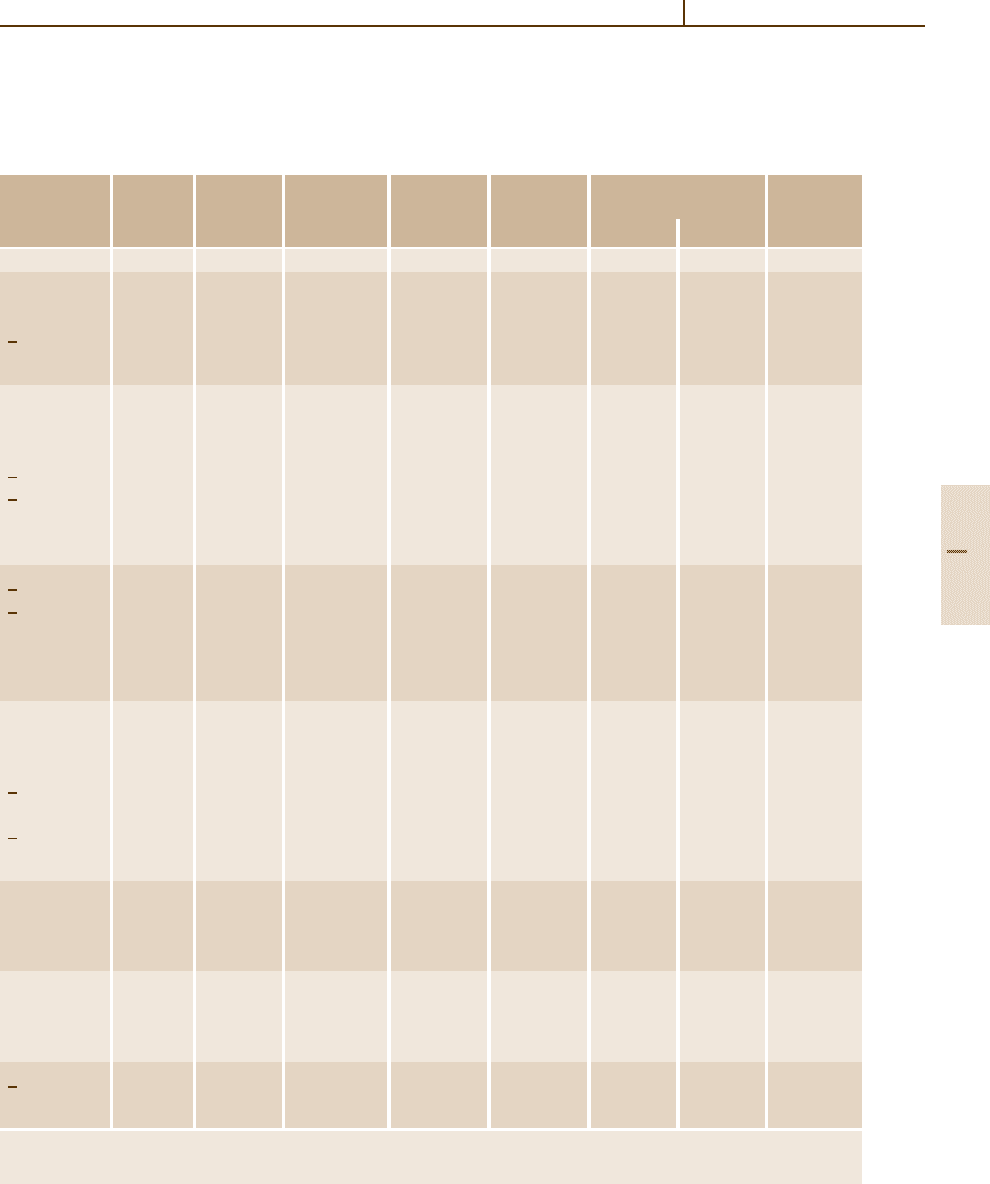
Dielectrics and Electrooptics 4.3 Guidelines for Use of Tables 827
all previous measurements relative to KDP and quartz
have been normalized to d
36
(KDP) = 0.39 pm/Vand
d
11
(SiO
2
) = 0.30 pm/V. These data lead to an accurate,
Table 4.4-2 Number of independent components of the various property tensors
Symmetry Dielectric Elastic Piezoelectric Elasto- Electro- Nonlinear Table
point group
tensor
a
tensor c
mn
tensor optic tensor optic tensor susceptibility tensors
b
number
ε
ij
or s
mn
d
imn
p
mn
or q
mn
r
mk
χ
(2)
χ
(3)
Isotropic 1(1) 2 0 2 0 0(0) 1(1) 4.4-3
Cubic:
432 (O) 1(1) 3 0 3 0 0(0) 2(2)
m3m (O
h
) 1(1) 3 0 3 0 0(0) 2(2) 4.4-4
43m (T
d
) 1(1) 3 1 3 1 1(1) 2(2) 4.4-5
23 (T ) 1(1) 3 1 4 1 1(1) 3(2) 4.4-6
Hexagonal:
6/mmm (D
6h
) 2(2) 5 0 6 0 0(0) 4(3)
6/m (C
6h
) 2(2) 5 0 8 0 0(0) 6(3)
622 (D
6
) 2(2) 5 1 6 1 1(1) 4(3)
6m2(D
3h
) 2(2) 5 1 6 1 1(1) 4(3) 4.4-7
6(C
6
) 2(2) 5 2 8 2 2(2) 6(3)
6mm (C
6v
) 2(2) 5 3 6 3 3(2) 4(3) 4.4-8
6(C
6
) 2(2) 5 4 8 4 4(3) 6(3) 4.4-9
Trigonal:
3m (D
3d
) 2(2) 6 0 8 0 0(0) 5(4) 4.4-10
3(C
3i
) 2(2) 7 0 12 0 0(0) 10(5)
32 (D
3
) 2(2) 6 2 8 2 2(2) 5(4) 4.4-11
3m (C
3v
) 2(2) 6 4 8 4 4(3) 5(4) 4.4-12
3(C
3
) 2(2) 7 6 12 6 6(5) 10(5)
Tetragonal:
4/mmm (D
4h
) 2(2) 6 0 7 0 0(0) 5(4) 4.4-13
4/m (C
4h
) 2(2) 7 0 10 0 0(0) 8(6) 4.4-14
422 (D
4
) 2(2) 6 1 7 1 1(1) 5(4) 4.4-15
42m (D
2d
) 2(2) 6 2 7 2 2(1) 5(4) 4.4-16
4mm (C
4v
) 2(2) 6 3 7 3 3(2) 5(4) 4.4-17
4(S
4
) 2(2) 7 4 10 4 4(2) 8(6)
4(C
4
) 2(2) 7 4 10 4 4(3) 8(6)
Orthorhombic:
mmm (D
2h
) 3(3) 9 0 12 0 0(0) 9(6) 4.4-18
222 (D
2
) 3(3) 9 3 12 3 3(1) 9(6) 4.4-19
mm2(C
2v
) 3(3) 9 5 12 5 5(3) 9(6) 4.4-20
Monoclinic:
2/m (C
2h
) 4(3) 13 0 20 0 0(0) 16(9)
2(C
2
) 4(3) 13 8 20 8 8(4) 16(9) 4.4-21
m (C
s
) 4(3) 13 10 20 10 10(6) 16(9)
Triclinic:
1(C
i
) 9(3) 21 0 36 0 0(0) 30(15)
1(C
1
) 9(3) 21 18 36 18 18(10) 30(15)
a
The number of principal refractive indices n
i
is given in parentheses.
b
The number of independent components for the case of Kleinman symmetry conditions is given in parentheses.
self-consistent set of absolute second-order nonlinear
coefficients [4.14]. All numerical data are for room
temperature (300 K) and in SI units.
Part 4 4.3
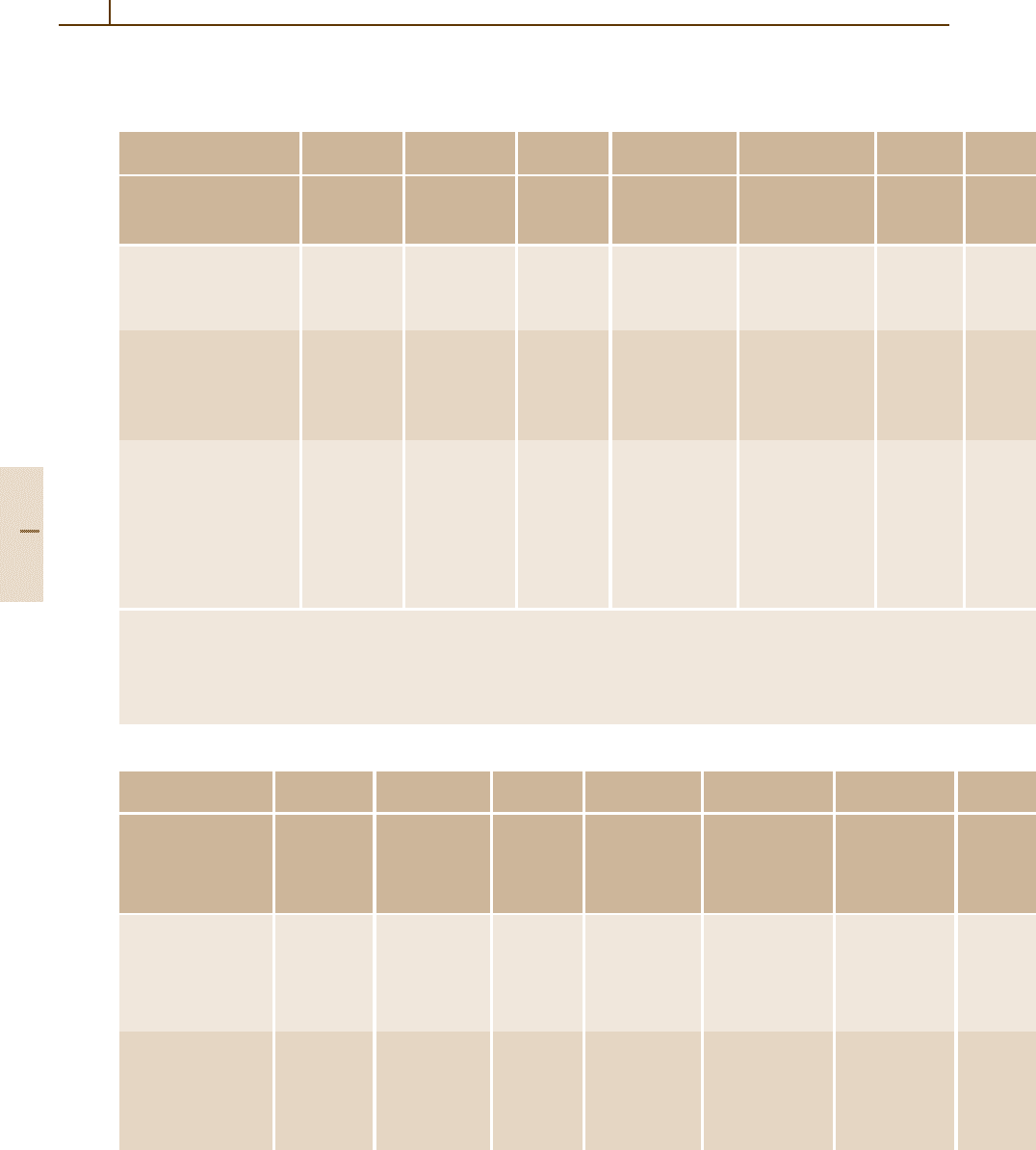
828 Part 4 Functional Materials
4.4.4 Tables of Numerical Data for Dielectrics and Electrooptics
Table 4.4-3 Isotropic materials
General Static dielectric Dissipation Elastic stiffness Elastic compliance Elastooptic
constant factor tensor tensor tensor
Material
g/cm
3
ε
S
11
tan δ
1
c
11
s
11
p
11
Mohs hardness ε
T
11
c
12
s
12
p
12
κ (W/mK) ( f (Hz)) (10
9
Pa)
10
−12
Pa
−1
BK7 Schott glass 2.510 92.325 (145) 12
b
–
– – −2
b
0.198 (22)
1.114 [4.15] [4.16] [4.15]
[4.17]
Poly(methylmethacrylate), 1.190 3.65 (19)
a
0.06 9.282 (30) 300
b
(C
5
H
8
O
2
)
n
2–3 [4.18] (50 Hz) – 8.9
b
[4.18]
(PMMA, Plexiglas) 0.2 [4.19] [4.18] [4.15]
Silicon dioxide, SiO
2
2.202 3.5
a
14 (5) ×10
−4
77.806 (185) 14
b
–
(Fused silica, 5–6 [4.20] (1 MHz) – −2.1
b
0.243 (17)
fused quartz, 1.38 [4.20] [4.15] [4.20] [4.15]
vitreous quartz) [4.21]
a
This value for ε
11
is neither at constant stress nor at constant strain.
b
The elastic compliances are at constant electric field
s
E
and have been calculated from the Young’s modulus via Y
0
= 1/s
E
and from the shear modulus via G =
2
s
E
11
−s
E
12
−1
.
Table 4.4-4 Cubic, point group m3m (O
h
) materials
General Static dielectric Dissipation Elastic Elastic Elastooptic
constant factor stiffness tensor compliance tensor tensor
Material
g/cm
3
ε
11
tan δ
1
c
11
s
11
p
11
Mohs hardness c
44
s
44
p
12
κ (W/mK) ( f (Hz)) c
12
s
12
p
44
(10
9
Pa)
10
−12
Pa
−1
p
11
− p
12
Barium fluoride, BaF
2
4.89 7.33 [4.21] 91.1(10) 15.2(1) 0.11
3 25.3(4) 39.6(7) 0.26
11 [4.21,22] 41.2(15) −4.7(1) 0.02
[4.7] [4.7] −0.14
(589–633 nm)
[4.23–25]
Calcium fluoride, CaF
2
3.179 7.4 [4.26] 165(2) 6.93(14) 0.027
(fluorite, fluorspar, 4.0 33.9(3) 29.5(3) 0.198
Irtran-3) 9.71 [4.21, 22] 47(3) −1.52(11) 0.02
[4.7] [4.7] −0.17
(550–650 nm)
[4.23,24,27]
Part 4 4.4
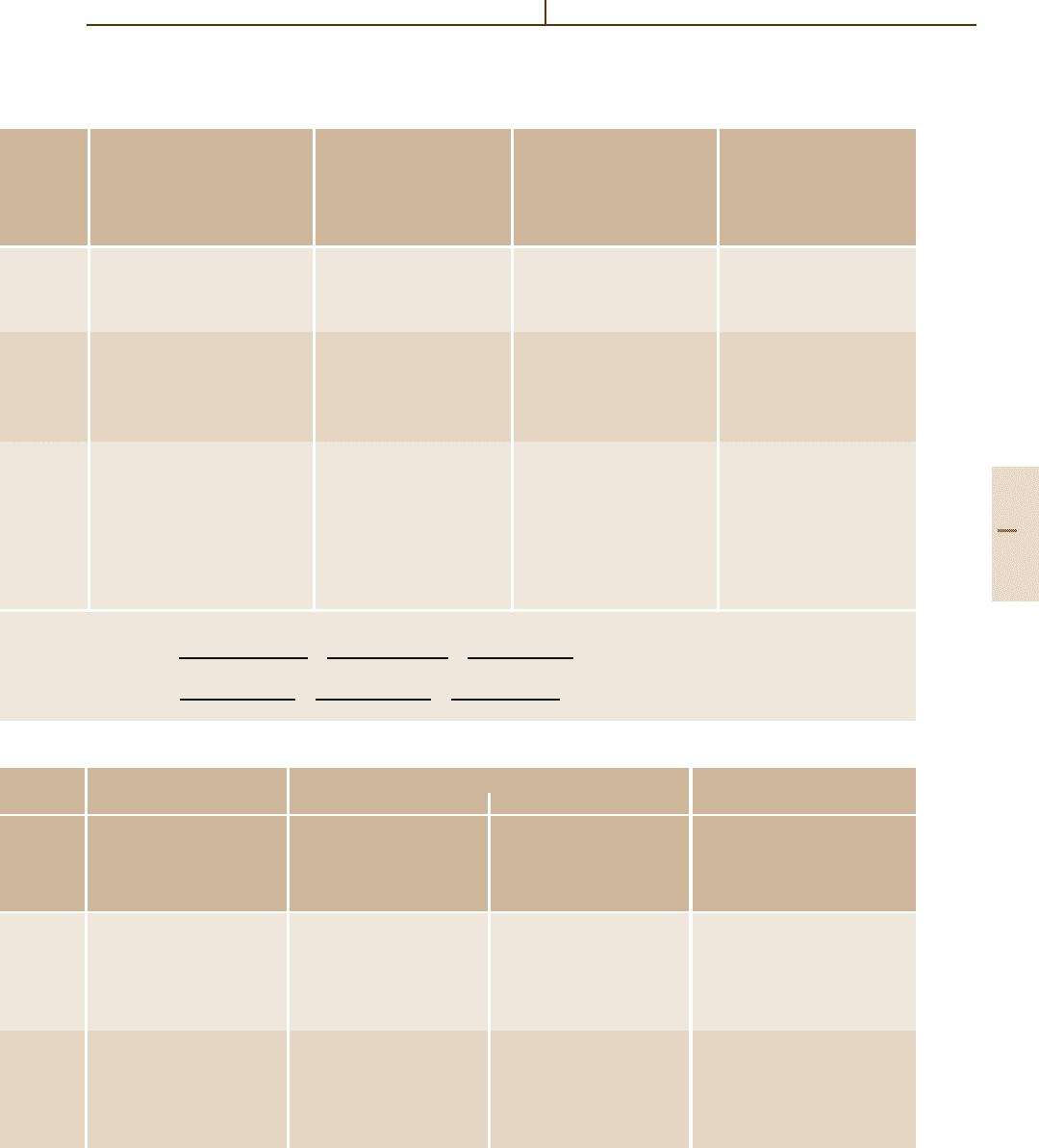
Dielectrics and Electrooptics 4.4 Tables of Numerical Data for Dielectrics and Electrooptics 829
Table 4.4-3 Isotropic materials, cont.
General optical Refractive index Two-photon absorption Nonlinear dielectric
properties n coefficient β susceptibility χ
(3)
1111
Transparency range (µm) (10
−9
cm/W)
10
−22
m
2
/V
2
dn/dT (10
−5
K
−1
)
0.35–2.8 [4.16, 28] 1.5067 [4.16] 0.006 (351 nm) [4.29] 2.7 ±0.2 [4.30]
0.28 (0.546 µm) [4.16] For dispersion relation, 0.0029 (532 nm) [4.31]
see
c
[4.28]
0.27–1.1 1.503 (0.436 µm)
− 1.493 (0.546 µm)
1.489 (0.633 µm)
1.481 (1.052 µm)
[4.32]
0.17–4.0 [4.22] 1.5343 (0.2139 µm) 0.75 (212.8nm) [4.33] 1.8 [4.34]
1.5 (0.21 µm) 1.4872 (0.3022 µm) 0.5 (216 nm) [4.35] 1.7±0.3 [4.36]
1.0 (0.4 µm) 1.4601 (0.5461 µm) 0.08 (248 nm) [4.37]
1.2 (2.0 µm) 1.4494 (1.083 µm) 0.045 (266 nm) [4.38]
1.0 (3.7 µm) 1.4372 (2.0581 µm)
[4.39] 1.3994 (3.7067 µm)
For dispersion relation,
see
d
[4.39]
cd
Dispersion relations (λ (µm), T = 20
◦
C):
c
n
2
= 1+
1+1.03961212λ
2
λ
2
−0.00600069867
+
0.231792344λ
2
λ
2
−0.0200179144
+
1.01046945λ
2
λ
2
−103.560653
;
d
n
2
= 1 +
1+0.6961663λ
2
λ
2
−(0.0684043)
2
+
0.4079426λ
2
λ
2
−(0.1162414)
2
+
0.8974794λ
2
λ
2
−(9.896161)
2
.
Table 4.4-4 Cubic, point group m3m (O
h
) materials, cont.
General Refractive index
a
Nonlinear dielectric
optical properties susceptibility
Transparency range (µm) n D χ
(3)
1111
dn/dT
10
−5
K
−1
A E χ
(3)
1122
B F χ
(3)
1133
C G
10
−22
m
2
/V
2
0.14–12.2 [4.40] 1.678 (0.150 µm) 1.4027 (9.00 µm) 1.548 ±0.17
−1.60 (0.633 µm) [4.41] 1.557 (0.200 µm) 1.3865 (11.0 µm) –
1.5118 (0.266 µm) 1.305 (15.0 µm) 0.636 ±0.06
−0.6(0.150 µm) 1.4744 (0.590 µm) dispersion (0.575; 0.613 µm)
−1.0(0.590 µm) 1.4683 (1.05 µm) relations, see [4.42]
−1.1(15.0 µm) [4.43] 1.4441 (6.00 µm) [4.43]
a
0.135–9.4 [4.40] 1.577 (0.150 µm) 1.3268 (9.00 µm) 0.8 ±0.24
−1.04 (0.633 µm) [4.44] 1.495 (0.200 µm) 1.268 (11.0 µm) 0.36±0.1
1.4621 (0.266 µm) 1.230 (12.0 µm) (0.575; 0.613 µm)
−0.1(0.150 µm) 1.4338 (0.590 µm) dispersion [4.42]
−1.5(0.590 µm) 1.4286 (1.05 µm) relations, see
−1.0(12.0 µm) 1.3856 (6.00 µm) [4.43]
b
Part 4 4.4
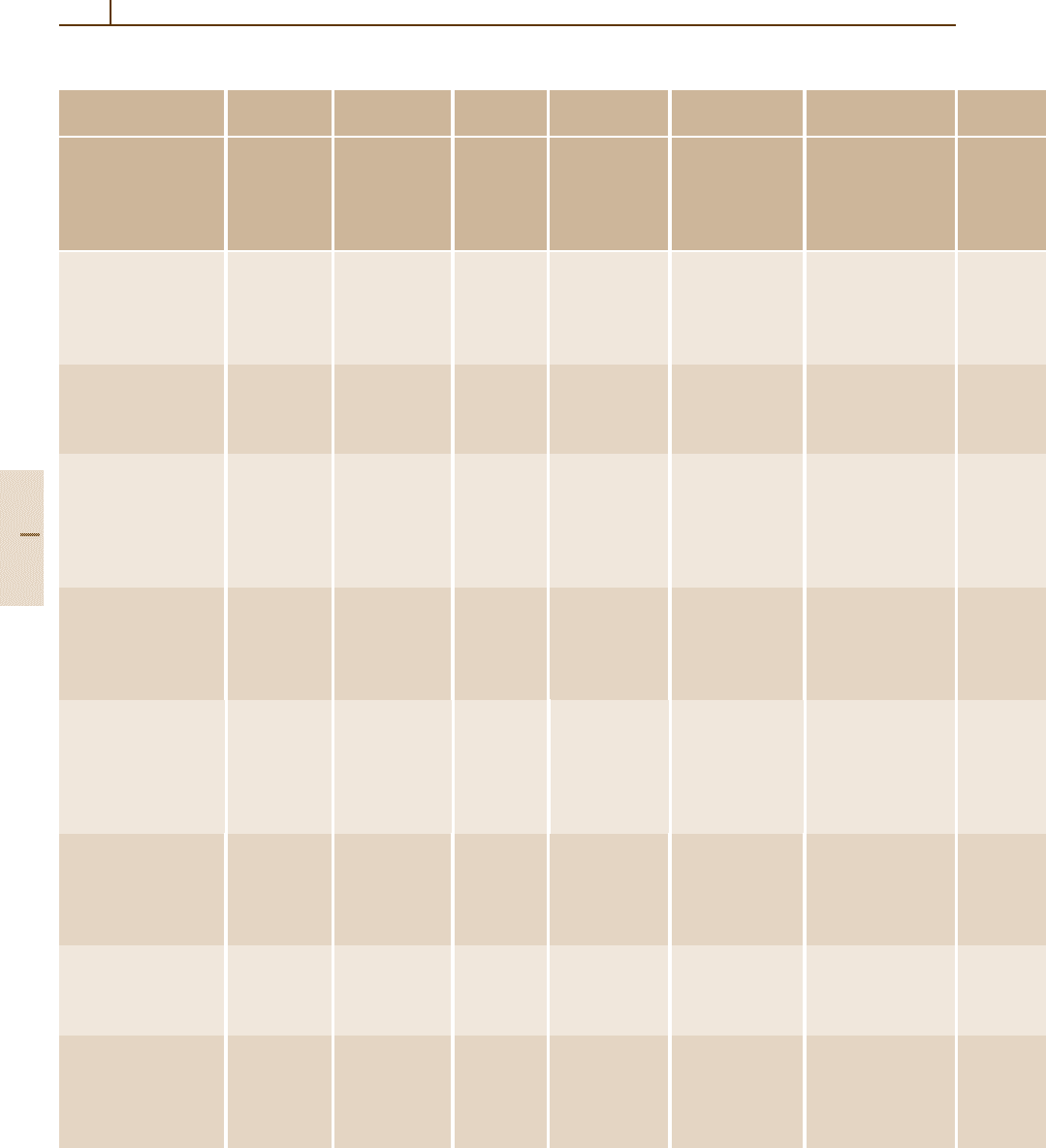
830 Part 4 Functional Materials
Table 4.4-4 Cubic, point group m3m (O
h
) materials, cont.
General Static dielectric Dissipation Elastic Elastic Elastooptic
constant factor stiffness tensor compliance tensor tensor
Material
g/cm
3
ε
11
tan δ
1
c
11
s
11
p
11
Mohs hardness c
44
s
44
p
12
κ (W/mK) ( f (Hz)) c
12
s
12
p
44
(10
9
Pa)
10
−12
Pa
−1
p
11
− p
12
Diamond, C 3.52 5.5–10.0 1077(2) 0.951(2) −0.25
10 [4.26] 577(1) 1.732(3) 0.04
660 (0
◦
C) 124.7(6) −0.0987(6) 0.17
[4.22,45] [4.7] [4.7] −0.30(1)
(514–633 nm) [4.46]
Germanium, Ge 5.33 16.6 [4.21] 129(3) 9.73(5)
6 67.1(5) 14.90(12)
58.61 [4.21] 48(3) [4.7] −2.64(11)
[4.7]
Lithium fluoride, LiF 2.639 9.1 [4.21] 112(2) 11.6(1) 0.02
4 63.5(6) 15.8(2) 0.13
4.01 46(3) −3.35(13) −0.04(1)
[4.21] [4.7] [4.7] −0.10
(589–633 nm)
[4.27,47]
Magnesium oxide, MgO 3.58 9.7 [4.26] 0.009 294(6) 4.01(4) −0.25
– (10 GHz) 155(3) 6.46(12) −0.01
42 [4.21] [4.48] 93(5) [4.7] −0.96(2) −0.10
[4.7] −0.24 (589 nm)
[4.27,49]
Potassium bromide, KBr 2.753 4.9 [4.21] 34.5(3) 30.3(6) 0.22
1.5 5.1(2) 196(6) 0.17 (546–600 nm)
4.816 [4.21] 5.5(4) −4.2(3) [4.50]
[4.7] [4.7] 0.02
0.04 (488–600 nm)
[4.51]
Potassium chloride, KCl 1.99 4.6 [4.26] 40.5(4) 25.9(1) 0.23
(sylvine, sylvite) 2 6.27(6) 159(1) 0.17
6.53 [4.21] 6.9(3) −3.8(3) 0.02
[4.7] [4.7] 0.05 (546–600 nm)
[4.50–53]
Potassium iodide, KI 3.12 5.6 [4.26] 27.4(5) 38.2(8) 1.21
– 3.70(4) 270(3) 0.15
2.1 [4.21] 4.3(2) −5.2(3) −0.031 [4.41]
[4.7] [4.7] −
Silicon, Si 2.329 11.0–12.0 165(2) 7.73(8) −0.094
7 [4.26] 79.1(6) 12.70(9) 0.017
163.3 [4.21] 63(1) −2.15(4) −0.051
[4.7] [4.7] −0.111 (3390 nm)
[4.54–57]
Part 4 4.4
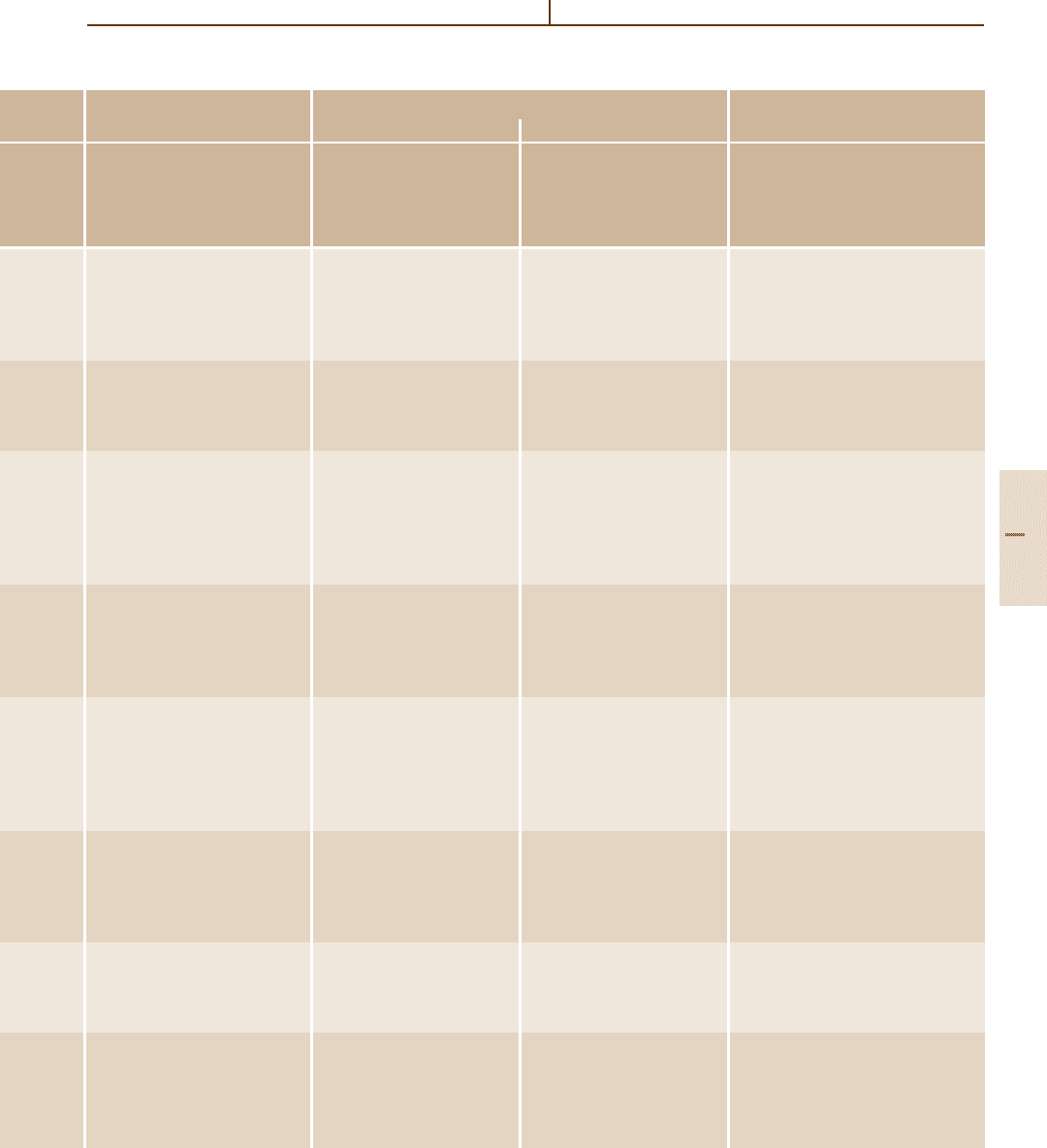
Dielectrics and Electrooptics 4.4 Tables of Numerical Data for Dielectrics and Electrooptics 831
Table 4.4-4 Cubic, point group m3m (O
h
) materials, cont.
General Refractive index
a
Nonlinear dielectric
optical properties susceptibility
Transparency range (µm) n D χ
(3)
1111
dn/dT
10
−5
K
−1
A E χ
(3)
1122
B F χ
(3)
1133
C G
10
−22
m
2
/V
2
0.24–27 2.7151 (0.2265 µm) For dispersion relation, χ
(3)
1122
= 4.87(12)
1.01 (0.546 µm) 2.4190 (0.578 µm) see
c
[4.58] χ
(3)
1111
+3χ
(3)
1122
= 30 ±0.8
0.96 (30 µm) 2.3914 (1.064 µm) (both at 0.407 µm) [4.42]
[4.59,60] χ
(3)
1111
+3χ
(3)
1133
= 65 ±20
(0.53 µm) [4.61]
1.8–15 [4.62] 4.0038 (10.6 µm) 0.21307 56 000±28 000
− 9.28156 3870.1 34 000±1200
6.72880 0 −
0.44105 0 [4.63]
d
(10.6 and 9.5 µm) [4.64]
0.120–6.60 1.387 6.96747 1.12(24)
− 1 1075 0.50
0.9259 0 −
0.005441 0 [4.65]
d
(0.6943 and 0.7456 µm)
[4.66]
0.35–6.8 [4.67] 1.7217 0.8460085 +1.4(2)
1.95 (0.365 µm) 1 0.01891186 –
1.65 (0.546 µm) 1.111033 7.808527 +0.77(15)
1.36 (0.768 µm) 0.00507606 723.2345 (0.6943 and 0.7456 µm)
[4.68] [4.69]
d
[4.66]
0.200–30 [4.40] 1.5435 15.7 [4.70]
−3.93 (0.458 µm) For dispersion relation, 5.8 [4.71]
−4.19 (1.15 µm) see
e
[4.65] 6.2 (0.6943 and 0.7456 µm)
−4.11 (10.6 µm) [4.41] [4.66]
0.18–23.3 [4.40] 1.4792 6.7 [4.70]
−3.49 (0.458 µm) For dispersion relation, 1.9 [4.71]
−3.62 (1.15 µm) see
f
[4.65] 0.8 (0.6943 and 0.7456 µm)
−3.48 (10.6 µm) [4.41] [4.66]
0.32–42 [4.21] 1.6393 1.4 ±0.3 (0.6943 and 0.7456 µm)
−4.15 (0.458 µm) For dispersion relation, [4.66]
−4.47 (1.15 µm) see
g
[4.65] –
−3.08 (30 µm) [4.41] –
1.1–6.5 [4.62] 3.4176 (10.6 µm) 0.003043475 24 300 [4.72]
− 1 1.2876602 –
10.6684293 1.54133408 33 000 [4.71] at 10.6 and 11.8 µm
0.09091219 1 218 820 [4.73]
d
χ
(3)
1111
= 2800
[4.74] χ
(3)
1122
= 1340 [4.75]
Part 4 4.4
